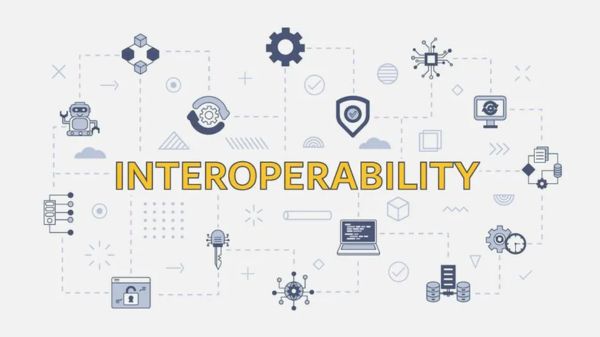The advent of blockchain technology has revolutionized numerous industries, facilitating secure and transparent transactions without the need for intermediaries. However, as blockchain networks expand, the lack of compatibility and interoperability between different systems has emerged as a significant obstacle. Enter blockchain interoperability, a concept designed to bridge the gap between these isolated networks and enhance collaboration. This blog post will delve into the world of what is blockchain interoperability, examining its functionality, importance, different solutions, and the advantages and disadvantages it brings.
Table of Contents
What is Blockchain Interoperability?
Blockchain interoperability refers to the seamless communication and interaction between different blockchain networks. It enables the transfer of data, assets, or value across diverse blockchains, regardless of their protocols or structures. The primary goal of interoperability is to break down the barriers hindering collaboration between decentralized systems, enabling them to exchange information and work together efficiently.

How does Blockchain Interoperability work?
Blockchain interoperability can be achieved through various approaches and protocols. One common method involves using interoperability protocols such as cross-chain bridges or connectors. These protocols act as intermediaries, facilitating the transfer of assets or data between different blockchain networks. They follow a set of rules and standards that define how information is exchanged, ensuring compatibility and security.
Another approach to achieving blockchain interoperability is through the implementation of sidechains. Sidechains are separate blockchains connected to a main blockchain but with their own specific rules and functionalities. They enable the transfer of assets between the main chain and the sidechain, facilitating interoperability between different systems.
The Importance of Blockchain Interoperability
Blockchain interoperability holds significant importance in decentralized systems for the following reasons:
- Enhanced Collaboration: Interoperability fosters collaboration between blockchain networks, allowing them to leverage each other's strengths and capabilities. It promotes innovation by enabling developers to build applications that integrate multiple blockchains, leading to a more robust and efficient ecosystem.
- Seamless Asset Transfer: Interoperability enables the transfer of assets across different blockchains, making it easier for users to access and utilize digital assets, regardless of the blockchain network they are stored on. This expands the utility and liquidity of assets, benefiting individuals and businesses.
- Scalability and Performance: Interoperability addresses scalability issues by distributing transactions across multiple blockchains. This helps alleviate network congestion and improves overall system performance.
- Reducing Single Points of Failure: Interoperability reduces reliance on a single blockchain network, mitigating the risk of a single point of failure. In the event of a network outage or security breach, interoperability allows operations to continue through alternative networks.

Types of Blockchain Interoperability Solutions
Several solutions have emerged to address the challenges of compatibility between decentralized systems. Some notable examples include:
- Cross-Chain Bridges: These solutions facilitate the transfer of assets between different blockchains by locking assets on one chain and creating equivalent representations on the target chain. This ensures the secure movement of assets across disparate networks.
- Atomic Swaps: Atomic swaps enable direct peer-to-peer exchanges between different blockchain networks without intermediaries. They allow users to trade digital assets in a trustless and decentralized manner.
- Sidechains: Sidechains provide interoperability by allowing the transfer of assets between the main chain and the sidechain. This approach offers scalability benefits while maintaining connectivity to the primary blockchain network.
Advantages of Blockchain Interoperability
- Improved Efficiency: Blockchain interoperability streamlines processes by enabling the seamless transfer of assets and data, reducing the need for manual intervention and intermediaries. This leads to enhanced operational efficiency and cost savings.
- Expanded Use Cases: Interoperability opens up new possibilities for blockchain applications by combining the strengths of multiple networks. This facilitates the development of complex decentralized applications (dApps) that can leverage various blockchain functionalities.
- Increased Liquidity: Interoperability makes digital assets more accessible and liquid as they can be utilized across different blockchain networks. This fosters a dynamic and vibrant ecosystem for users and investors.

Disadvantages of Blockchain Interoperability
- Security Risks: Interoperability introduces additional attack vectors, as communication between different blockchain networks can potentially create vulnerabilities. Implementing robust security measures is crucial to mitigate these risks effectively.
- Complexity: Achieving interoperability between different blockchains can be technically challenging and complex. Integrating disparate protocols and coordinating multiple networks require careful planning and development expertise.
By knowing what is blockchain interoperability, we know that it holds immense potential in revolutionizing decentralized systems. By enabling seamless communication and collaboration between different blockchain networks, it paves the way for a more interconnected and efficient ecosystem. However, it is crucial to address the associated challenges and implement robust security measures to ensure the safe and effective operation of interoperable solutions. As blockchain technology continues to evolve, interoperability will play a vital role in shaping the future of decentralized systems, unlocking new possibilities and driving widespread adoption. Follow U2U for more blockchain and crypto market updates.






